Are you looking to revamp your office space? Small changes can have a significant impact on your work life, making it more efficient, productive, and enjoyable. In this article, we will explore nine office interior design ideas that can transform your workspace. From incorporating natural light to using technology, these ideas will help create a functional and visually appealing office environment.
1. Incorporate Natural Light
Incorporating natural light into your office design has become a popular trend in recent years, and for a good reason. Natural light offers numerous benefits in the workplace, such as increased productivity and a bright and welcoming atmosphere. Here are some strategies to incorporate natural light:
a) Open Floor Plans
Open floor plans allow natural light to flow freely throughout the space, eliminating the need for artificial lighting. By removing walls and barriers, every corner of the office can be illuminated with natural light. It creates a bright and inviting environment.
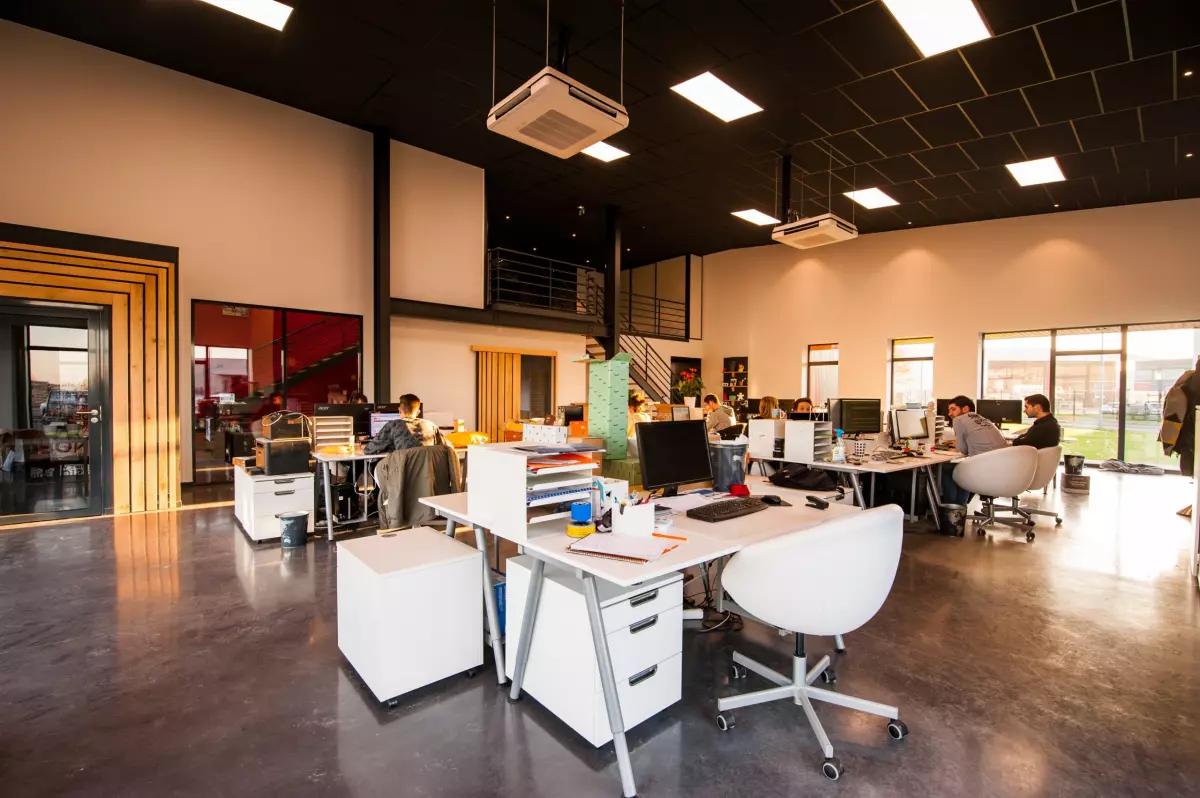 Image credit: gra-gcc.com
Image credit: gra-gcc.com
b) Large Windows
Install large windows in your office to provide stunning views of the surrounding area and allow ample natural light to flood the room. Large windows also create a sense of openness and transparency, enhancing collaboration and teamwork.
c) Skylights
Skylights are an excellent solution for bringing natural light into central areas of the office, such as conference rooms and communal spaces. They are especially useful when windows are impractical.
d) Light Shelves
Light shelves are innovative installations above windows that bounce natural light deeper into the room. They use reflective surfaces to direct sunlight further into the office space, enhancing the overall brightness.
e) Light Tubes
Light tubes are perfect for bringing natural light into interior spaces that are not adjacent to windows. They are installed in the ceiling and use reflective surfaces to direct sunlight into the room, creating a well-lit workspace.
f) Glass Partitions
Glass partitions are an excellent way to divide office space while allowing natural light to flow. They maintain privacy and focus while ensuring that employees enjoy the benefits of natural light.
2. Create Designated Zones
Designated zones optimize the functionality and flow of office space. Here are some ideas for creating designated zones in your office:
a) Reception Area
Make your reception area welcoming and comfortable. Provide comfortable seating and a visible reception desk to create a positive first impression for visitors.
b) Workstations
Based on the size of your office, create different workstations such as standing desks, cubicles, or shared workspaces. Ensure they are well-lit, have ample storage, and easy access to power outlets.
c) Meeting Rooms
Designate specific areas for small and formal meetings. Equip them with the necessary technology, such as projectors or video conferencing systems.
d) Break Areas
Employees need designated spaces for breaks and relaxation. Include a kitchen or break room with comfortable seating and a refrigerator for snacks and drinks.
e) Quiet Zones
Create zones where employees can work without distractions, allowing them to focus and be productive.
f) Collaborative Zones
Encourage teamwork and creativity by creating communal areas such as brainstorming or collaboration tables. Provide ample lighting and tools for brainstorming.
g) Flexibility
Designated zones are helpful, but it's also essential to create flexible spaces that can adapt to different needs. For example, a meeting room can be transformed into a temporary workspace.
3. Add Plants
Using plants for interior office design adds natural beauty and improves the overall ambiance. Here are some ideas to incorporate plants into your office:
 Image credit: petaltothemetalflowers.uk
Image credit: petaltothemetalflowers.uk
a) Create a Green Wall
A green wall, also known as a living wall, involves covering a wall with plants grown in a vertical arrangement. It enhances the overall aesthetics, reduces noise levels, improves air quality, and increases productivity.
b) Use Plants as Dividers
Plants can be used as natural partitions between office areas. For example, tall plants can separate a reception area from the workspace.
c) Add Potted Plants
Adding potted plants to your office is an easy way to bring greenery. Choose plants that are low-maintenance, such as succulents or cacti, or create elaborate arrangements with various plants.
d) Hang Plants
Hang plants from the ceiling or place them on shelves to add visual interest. Trailing foliage plants like ivy or ferns create a dramatic effect.
e) Create a Plant Corner
If you have ample space in your office, create a dedicated plant corner. This area can serve as a relaxing space for employees to take a break and recharge. Incorporating plants into your office enhances the aesthetic appeal and offers health and environmental benefits.
4. Use Ergonomic Furniture
Ergonomic furniture improves employee wellness, comfort, and productivity. It supports the natural posture and movements of the human body, reducing the risk of musculoskeletal disorders. Here are some tips for incorporating ergonomic furniture into your office:
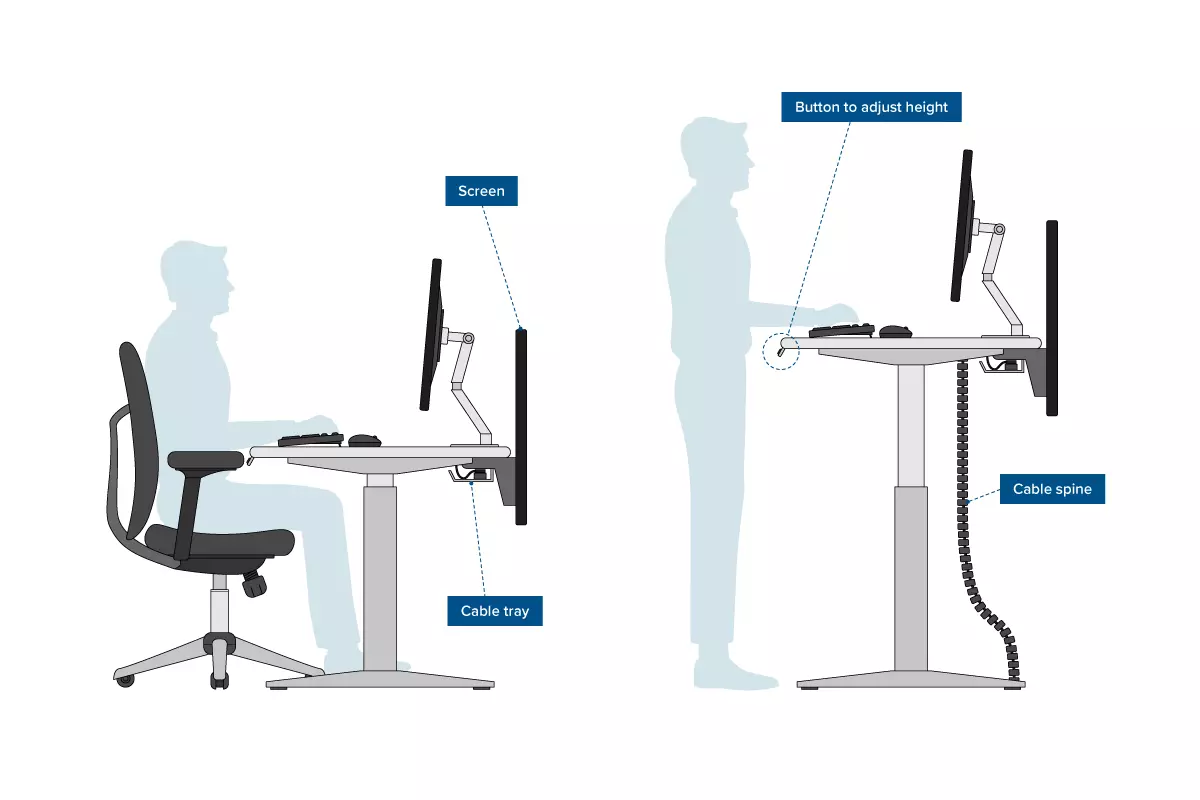 Image credit: shopz.off-75.ml
Image credit: shopz.off-75.ml
a) Choose Adjustable Desks and Chairs
Opt for adjustable furniture that allows employees to customize their workstations. Adjustable desks can be raised or lowered to accommodate different tasks and postures. Adjustable chairs provide comfort with customizable height, seat depth, and backrest angle.
b) Use Supportive Seating
Provide ergonomic office chairs with lumbar support and contoured seats to maintain a healthy posture and reduce the risk of back pain. Adjustable armrests can also reduce strain on the shoulders and neck.
c) Provide Standing Desks
Standing desks help break up prolonged periods of sitting, improving blood flow and alertness. Combine standing desks with seated workstations for maximum flexibility.
d) Consider Ergonomic Accessories
Incorporate ergonomic accessories like keyboard trays, monitor arms, and footrests to improve posture and reduce strain on the neck, shoulders, and wrists. Creating a comfortable and healthy workspace is crucial for employee well-being and productivity.
5. Consider Acoustics
Acoustics play a vital role in creating a comfortable and productive office environment. Here are some ideas for optimizing acoustics in your office design:
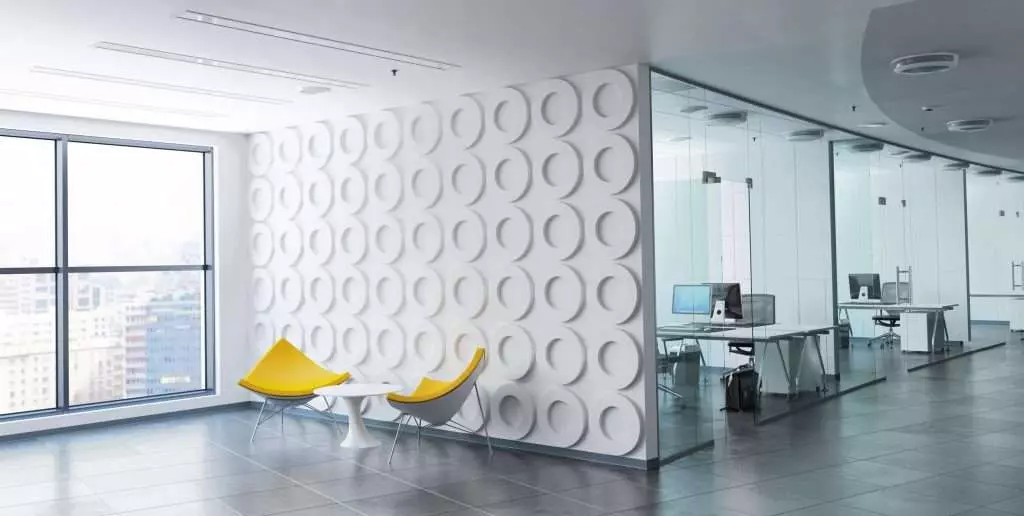 Image credit: sound-zero.com
Image credit: sound-zero.com
a) Use Sound-Absorbing Materials
Incorporate materials that absorb sound, such as carpets, ceiling tiles, and wall panels. Using these materials can reduce noise levels and create a more pleasant work environment.
b) Create Designated Quiet Areas
Designate specific areas in the office as quiet zones where employees can work without distracting noise. Use partitions, walls, or furniture to create these zones.
c) Use Sound Masking
Install sound masking systems that produce low-level background noise to mask unwanted noise. This is particularly useful in open-plan offices where multiple conversations take place.
d) Position Workstations Strategically
Place workstations away from busy traffic areas or near sound-absorbing materials to minimize noise levels and create a quiet work atmosphere.
e) Consider the Use of Plants
Incorporating plants into the office design helps absorb sound and create a more pleasant work environment. Additionally, plants improve air quality and offer aesthetic benefits.
6. Geometry
Incorporating geometry into interior design creates a visually striking and modern office space. Here are some ideas to consider:
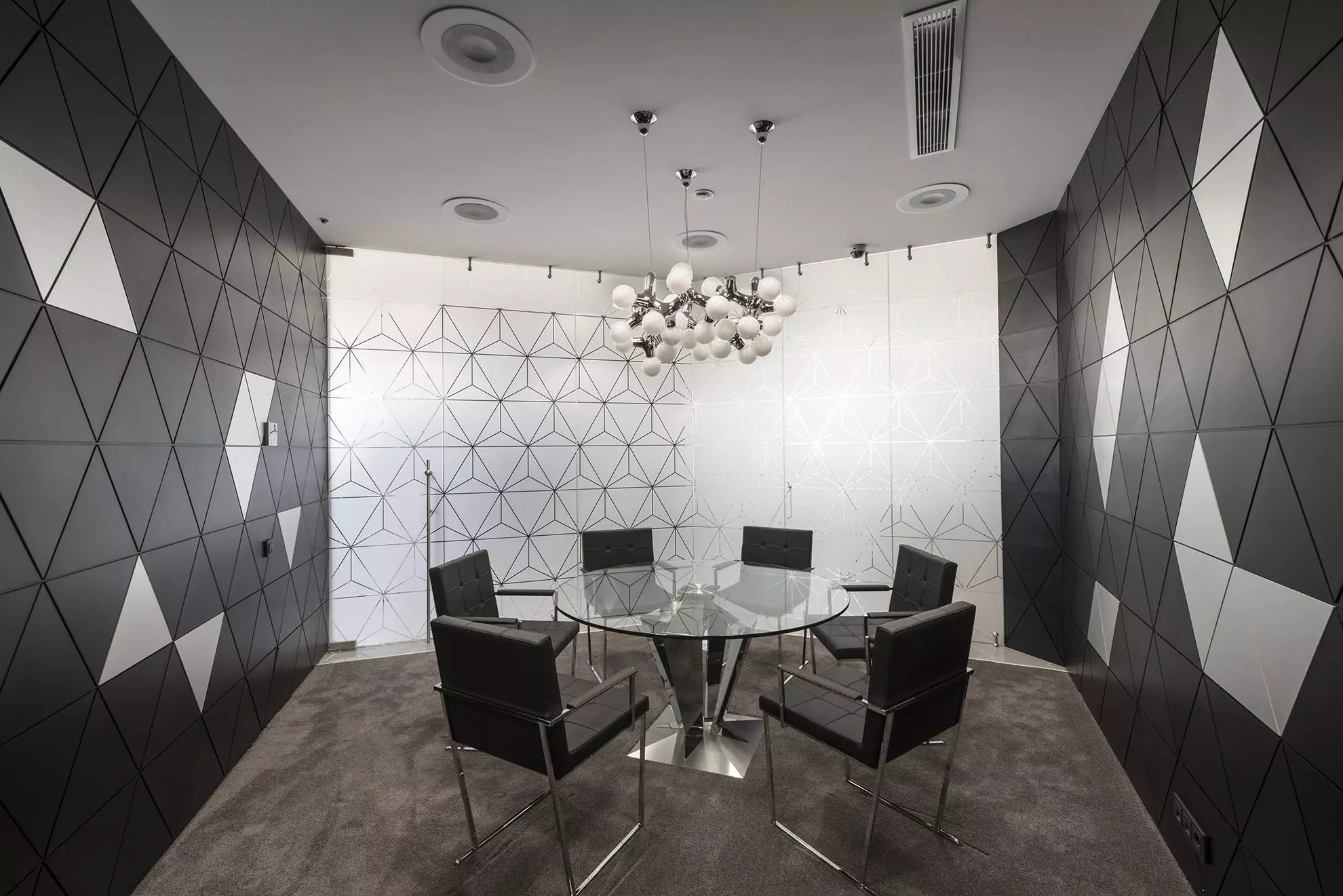 Image credit: luxurious-studio.com
Image credit: luxurious-studio.com
a) Geometric Patterns
Use geometric patterns in flooring, textiles, or as wallpaper ideas. Create a feature wall with a geometric print or use geometric shapes in the flooring to add movement.
b) Angled Furniture
Consider using angled furniture like desks and bookshelves to add visual interest and create a dynamic space.
c) Bold Lines
Use bold lines in light fixtures, artwork, and architecture to create a sense of depth and dimension in the office.
d) Color Blocking
Incorporate geometric color blocking using contrasting colors in a geometric pattern. This can be achieved through furniture, textiles, or wall paint.
e) Three-Dimensional Shapes
Use three-dimensional shapes such as pyramids or hexagons to add texture and depth to the office. Decorative elements like wall art or sculptures can achieve this effect.
7. Wall Art
Incorporating wall art into your office design enhances the aesthetics and creates an inspiring work environment. Here are some tips for effectively using wall art:
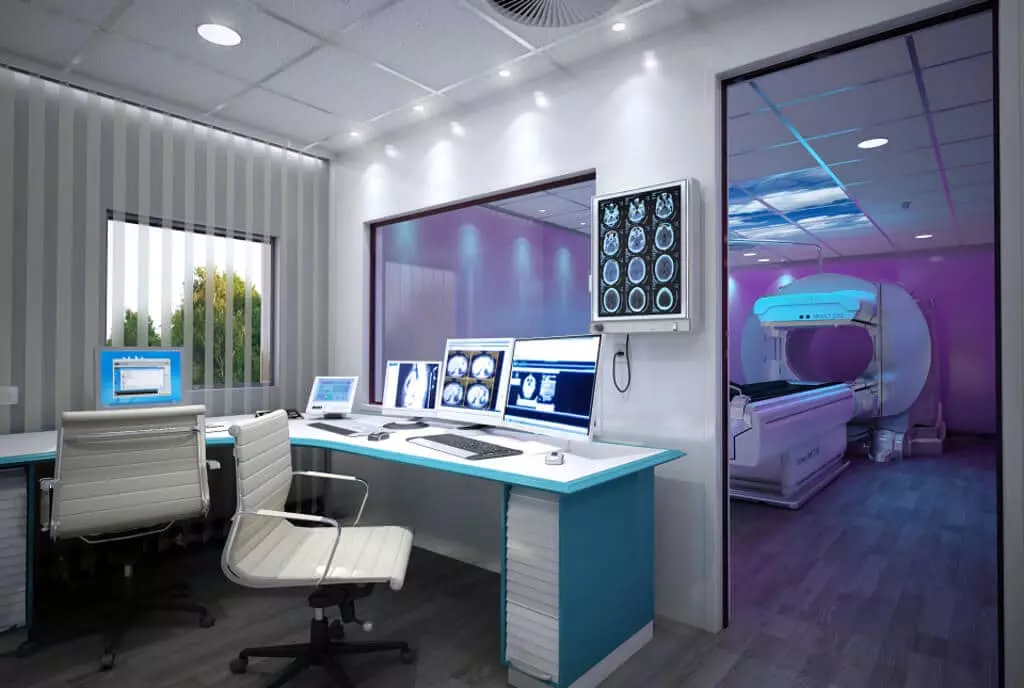 Image credit: nmbvcx.cf
Image credit: nmbvcx.cf
a) Consider Your Brand and Company's Culture
Choose art that reflects your brand's color palette, values, and mission. Align the wall art with your brand's identity.
b) Choose the Right Size and Scale
Select wall art that fits the size of your office space. Larger art pieces work well in spacious areas, while smaller ones can be used in smaller sections of the office.
c) Mix and Match Styles
Combining various art styles and mediums adds interest and depth to your office design. Mix framed prints, canvas paintings, and sculptural pieces.
d) Create a Focal Point
Use a large, eye-catching art piece as a focal point in your office to draw attention and create a sense of drama.
e) Use Color Strategically
Choose artwork that features or complements your brand's color scheme. Use art to add pops of color and create a vibrant atmosphere.
f) Remember Texture
Incorporate different textures into your wall art, such as woven pieces, metal sculptures, or framed textiles. Texture adds visual interest and makes your office design more dynamic.
8. Biophilic Design
Biophilic design incorporates elements of nature into the workspace to improve well-being and productivity. Here are some ideas to implement biophilic design:
 Image credit: blog.interface.com
Image credit: blog.interface.com
a) Incorporate Natural Light
Maximize natural light by using large windows or skylights. Natural light regulates sleep patterns and enhances overall well-being.
b) Add Plants
Plants purify the air, reduce stress, and add visual appeal. Choose plants that are suited to the lighting conditions in your office.
c) Use Natural Materials
Incorporate raw materials like wood, stone, and bamboo into your design. These materials provide warmth, texture, and a connection to nature.
d) Create a Green Wall
A green wall helps reduce noise levels, improves air quality, and provides a calming visual element. It serves as a centerpiece for beautiful and chic commercial interior design.
e) Incorporate Water Features
The sound of running water reduces stress and creates a sense of tranquility. Add a small fountain or waterfall to your office design.
f) Use Natural Colors
Choose earthy tones like greens, browns, and blues to create a calming and soothing atmosphere. These colors evoke a sense of connection with nature.
g) Provide Views of Nature
Offer views of nature from windows or use nature-inspired artwork to create a connection with the outdoors.
9. Integrating Technology
Integrating technology into office interior design enhances productivity, collaboration, and employee satisfaction. Here are some ideas for incorporating technology:
 Image credit: architecturesideas.com
Image credit: architecturesideas.com
a) Bright Lighting
Use intelligent lighting systems that adjust brightness and color temperature according to the time of day or task. This reduces eye strain and improves employee comfort.
b) Digital Signage
Install digital signage in common areas to display important information, announcements, and company news. Showcase employee achievements and recognition on these displays.
c) Interactive Displays
Incorporate interactive displays in meeting rooms and conference areas for collaboration and brainstorming. Use them for whiteboarding, note-taking, and presentations.
d) Wireless Charging
Provide wireless charging stations throughout the office for convenient device charging without cords and cables.
e) Virtual Meeting Technology
Install video conferencing equipment and software to facilitate remote meetings and collaboration. Webcams, microphones, and software like Zoom or Microsoft Teams enhance connectivity.
f) Smart Desks
Utilize height-adjustable desks with built-in technology to track employee activity, monitor ergonomics, and remind employees to take breaks.
In conclusion, office interior design plays a crucial role in creating a successful and effective workplace. By implementing these ideas, you can transform your office into a space that reflects your brand, enhances productivity, and supports employee well-being. Remember that a well-designed workplace is an investment in your company's success, boosting employee satisfaction and overall performance.









